For someone interested in Los Angeles art, Pacific Standard Time (PST), the Getty Initiative that connects over 60 Southern California cultural institutions and museums in an 11-month exploration and celebration of postwar Los Angeles culture, feels like a limited-time offer for an all-you-can-eat buffet. I have been visiting my parents’ home less and less over the past few years, feigning adulthood, but the advent of PST has rekindled my interest in visiting the old ancestral stomping grounds. This school year (2011-2012), I am capitalizing on my family connections and making three trips to Southern California—over Thanksgiving break, winter break, and in February for the CAA conference—to take in as much of PST as possible. Here, I’ll report on my pilgrimage in a series of three posts.

Itinerary: 10 exhibitions, 1 panel
Money spent on parking: $26
Money spent on tickets: $10
Tanks of gas: 2.5
Freeways traveled: the 10, PCH, the 60, the 5, the 91
Exhibition catalogs purchased: 1
Tchotchkes purchased: Corita mugs ($52.50 for four)
My November trip to PST was only four days long, so I packed in as much as I could, the priority being exhibitions that would close before my next trip. This emphasis made for a diverse and surprising itinerary.
On Friday, 18 November, my indulgent mother picked me up from John Wayne Airport, and on the way home we stopped by the University Art Gallery at UC Irvine to see The Radicalization of a ‘50s Housewife: A Solo Project by Barbara T. Smith [$2 parking; free entry]. This was not a great exhibition with which to inaugurate my mom’s PST experience, which I realized as soon as we walked in and saw a large dildo on a podium. The show is organized in two parts: the front gallery is dedicated to ephemera and props from Smith’s performance, Birthdaze (1981), and the back gallery contains earlier work by Smith, along with more personal items such as newspaper clippings and family photos. The “radicalization” of Smith is clearly conveyed through the juxtaposition of her early life as a debutante and young wife and her 1981 performance, which concluded with a Tantric sex ceremony. Smith was (and is) a pioneer of feminist performance art, and her work is featured in several other PST exhibitions.

The famously precise Irwin would develop an ulcer if he saw how this piece was installed.
Friday was “Malibu day.” I brought my sister with me on this trip, and we drove up the coast to Pepperdine University for California Art: Selections from the Frederick R. Weisman Art Foundation [free parking; free entry]. Pepperdine is one of those Southern California schools that makes you simultaneously hate and envy its students, who stroll up and down the hills with shiny hair or meander past in BMWs. The Weisman family has long collected art by Californian artists, and in some ways the Pepperdine exhibition of their holdings seemed almost too enthusiastic, as if curatorial joy at having finally secured widespread interest could not be contained. Pieces were crammed into every corner—even above the thermostat and by the elevator. Several of the works shown were major pieces, including one of Robert Irwin’s discs; paintings by John McLaughlin and Mary Corse; sculpture by John McCracken and De Wain Valentine; works on paper by Ed Ruscha, John Baldessari, David Hockney, and Ed Moses; and the exhibition icon, Yellow-Blue (1965) by Craig Kauffman. Unfortunately, the “finish fetish” of the works (NB: that is the first and last time I will use that phrase in these posts) was not kind to the Pepperdine galleries, which have stained carpets and bad lighting, and the quality of the work undermined the venue in which it was shown.
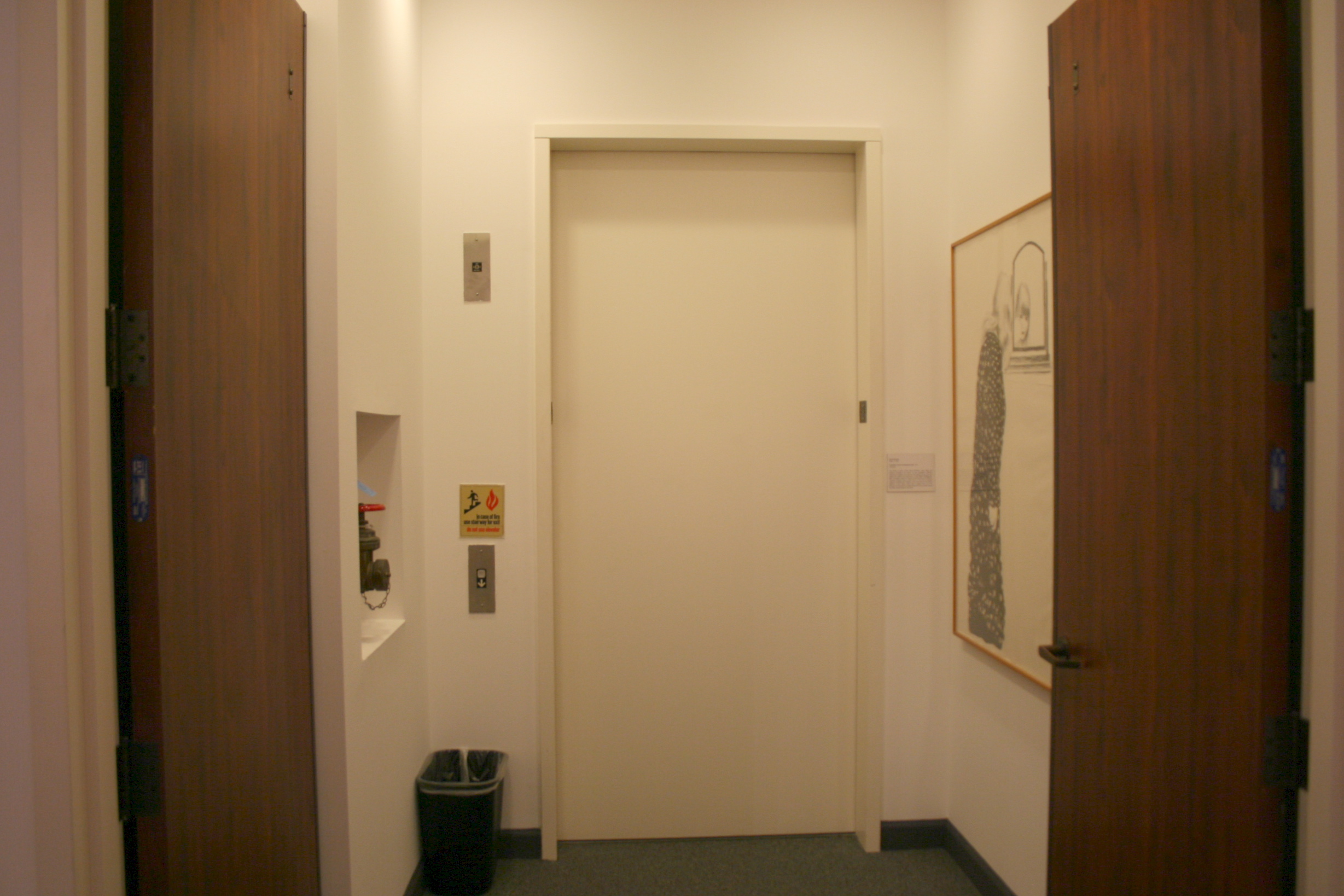
Installed in a corner next to the elevator of the Frederick R. Weisman Museum of Art.
That afternoon, I dragged my sister to a discussion event at the J. Paul Getty Museum unambitiously titled “How Los Angeles Invented the World” [$15 parking; free entry] to stalk hear my advisor, Thomas Crow. The event was divided into three panels: “How Los Angeles Created the Good Life,” moderated by Crow and including author Kirse Granat May, historian Eric Avila, and curator Jennifer Watts; “How Life Imitated Art,” moderated by critic Reed Johnson and including film directors William Friedkin and Thom Andersen, historian Richard Schickel, and critic Kenneth Turan; and “The Past and Future of L.A.’s Global Image,” moderated by radio host Warren Olney and including film directors Wim Wenders and John Singleton, writer Richard Rodriguez, and architect Eric Owen Moss. Crow’s panel dealt with issues of popular culture and image dispersal, tracing how California became an ideal for mid-century Americans of what it meant to live well (oddly enough, having appropriated some Midwestern ideals in the process, and sometimes utilizing them to represent or capitalize on the paranoia of the Cold War period). The second panel was, in my opinion, a complete disaster, as it devolved into old-chap nostalgic back patting and competitive obscure referencing. The third panel moved outward and onward, attempting to understand what Los Angeles’s global image has been and what its place will be in the future. As a former Angeleno, Wenders offered the analogy of a giant feedback loop: L.A. creates a portrayal of itself, simultaneously disseminating it and consuming it. That representation and its reception then affect the city’s self-image, which is immediately adjusted based on this recent consumption in a never-ending pattern of revision.
One of the main obstacles that PST has been facing since it was first publicized was made manifest during the event’s Q&A time. Several audience members began their comments with the equivalent of a biographical GPS, locating themselves within the Los Angeles community as having “been born and raised in Silver Lake” or “lived in Westwood for twenty years.” Many of these speakers were defensive about their own conception of Los Angeles based on unique experience, particularly in comparison with the bogeyman of NYC. There have been charges of “boosterism” and “regionalism” leveled against PST, the most distasteful of which was quoted from the mouth of Dave Hickey in a New York Times article (the article itself was subject to some funny commentary). While PST exhibitions and representatives should avoid blind promotion, the entire point of the initiative is to introduce a corrective to the art historical canon, and the audience is not just New Yorkers. I lived in Southern California from infancy to adulthood and had never heard of many of the artists about whom I am finally, voraciously, learning.
Some of these artists I discovered in an exhibition consistently ranked among the best in the initiative: the Museum of Contemporary Art San Diego’s Phenomenal: California Light, Space, Surface [free parking; free entry <25]. On Sunday I packed my mother into the car again and made the pilgrimage down to San Diego. (As an aside, the northernmost exhibition in PST is in Santa Barbara, and MCASD is hosting the southernmost. My parents happen to live at the ideal center point, two hours from each of these extremities. Considerate of them!) I will resist the urge to ramble at length about this fantastic exhibition, since alumna Sarah Zabrodski has written a thoughtful piece on it already. Just to say, if you attend any PST exhibition, all three venues of this exhibition should be in contention—and take a companion with you. Experiencing the phenomenological affects of Bruce Nauman’s Green Light Corridor and Eric Orr’s Zero Mass with my mom was priceless, even though they made her slightly nauseated. Also, MCASD knows how to install an Irwin.
The next day was a marathon of seven exhibitions, visited all by my lonesome. First I made the drive out to Santa Monica to see Collaboration Labs: Southern California Artists and the Artists Space Movement at the 18th Street Arts Center [free parking—good luck finding it; free entry] and She Accepts the Proposition: Six Women Gallerists in the Sam Francis Gallery of Crossroads High School [free parking, free entry]. These two small shows proved gems, both. She Accepts the Proposition was a small but very strong show, presenting archival documentation and art to highlight some of the female gallerists who kickstarted the Los Angeles art scene. Collaboration Labs consists of a room with three video screens and a console in the center, and viewers can watch the videos at their discretion. I chose documentation of the performance In Mourning and Rage by Suzanne Lacy and Leslie Labowitz-Strauss (1977); Conan the Waitress by Mark Addy and Graham Dent (1983); and Satellite Arts Project by Sherrie Rabinowitz and Kit Galloway (1977). While I was enjoying the hilarious camp of Conan the Waitress, a man came in and sat for two minutes. Before leaving, he asked me how many exhibitions I’d seen as an excuse to let me know that he’d visited thirty-six; presumably, he left so quickly so he could knock another show off his checklist.

Photograph by Harry Gamboa, Jr. (printed 2011). Courtesy LACMA.
Traveling from the small and obscure to the vast and institutional, I made the last stop of my day at the Los Angeles County Museum of Art (LACMA) [$9 parking; $10 student entry]. The museum is hosting five PST-specific exhibitions, but I was especially eager to see ASCO: Elite of the Obscure, A Retrospective, 1972-1987 before it closed. The show exhaustively covered ASCO’s activities throughout the fifteen years of its existence, documenting performance, video, and installation pieces that grapple with issues of Chicano politics and identity. Walking Mural (1972) recasts a stereotype of Latin American art, and provided a fruitful dialogue with the one-room exhibition Mural Remix: Sandra de la Loza, also at LACMA. Sandra de la Loza’s digital “remix” deals with the history of muralism in a millennial iteration, as her filmed subjects create and recreate murals on their own bodies.
California Design, 1930-1965: “Living in a Modern Way” is a major PST exhibition at LACMA that includes furniture, clothing, album covers, a car, and even a reconstruction of the Eames’ living room as evidence of the state’s prolific mid-century production of influential design. It reifies the arguments present in Crow’s Getty panel about the utopian vision of California that was presented to the world, but the show also accounts for the underbelly of fear regarding nuclear war and Communist infiltration. Another show, Maria Nordman Filmroom: Smoke 1967 – Present, displays the artist’s film in two iterations and is accompanied by a sculpture outside in the plaza. But the work that grabbed me most strongly was the subject of the remaining LACMA exhibition: Kienholz: Five Car Stud 1969-1972, Revisited. Kienholz is famous for his gutsy and evocative assemblages, often created with found furniture and objects such as chicken wire, mannequin parts, or Halloween masks. Five Car Stud uses full-size cars and plaster casts to create the haunting scene of a black man being castrated by a group of white men, and it is as affecting as it sounds. Hushed visitors wander through the tableau, witnessing the scene and leaving footprints in the dirt as evidence of their presence and unavoidable complicity.

In the tradition of travelogues, the intrepid sightseer records his or her observations and impressions of exotic places and fantastical events to a distant audience. Pacific Standard Time comprises many sites, requiring a dedicated viewer to traverse multiple freeways and the affiliated traffic to see even a minimum of exhibitions. This trait has been listed as a fault, but I don’t agree with that interpretation. Instead, the diffuse nature of the institutions exposes PST to the greatest possible audience: someone living in Palm Springs, Long Beach, Claremont, or any other number of southern California cities and counties can see her local PST show, which may then open her up to the plethora of other exhibitions. I believe a more pressing concern than fractured geography is that the majority of these exhibitions are not traveling, but instead are being packed away as soon as PST ends. The limitation of the initiative is not dispersal but time, and the distance with which to be concerned is not between the exhibitions but between the exhibitions and the full scope of their potential audience. As the program winds down through the spring, the sense of urgency increases: to capitalize on this opportunity with publications and research, and to prevent PST from proving only a flash in the pan with no lasting effect on the discipline.
In Part 2, I’ll recount my adventures at over 20 PST venues from December 2011.

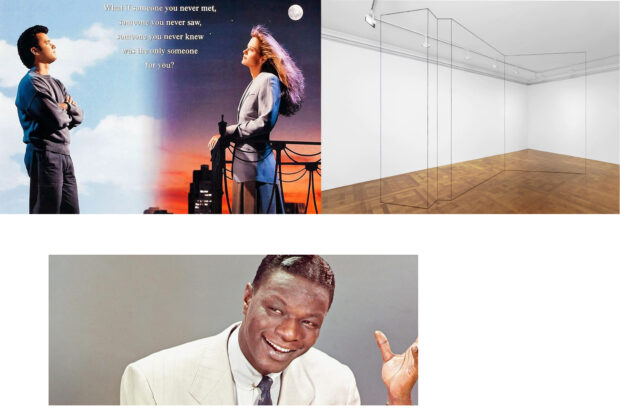


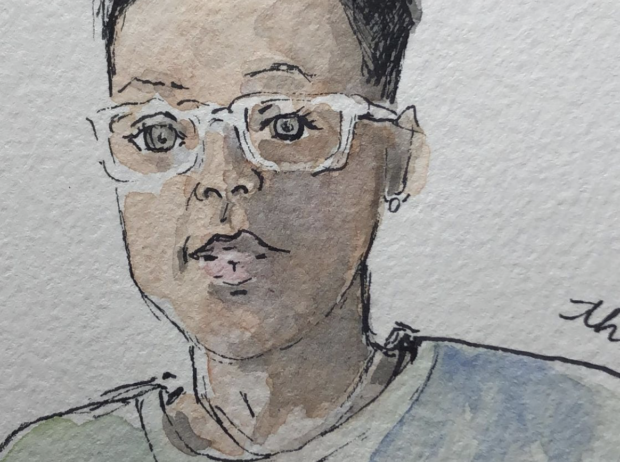
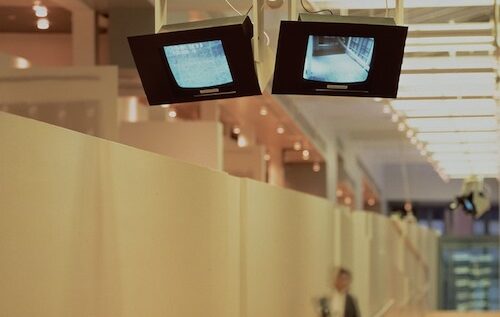

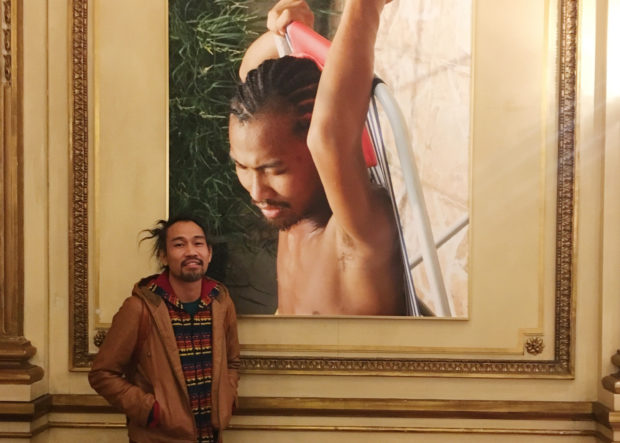
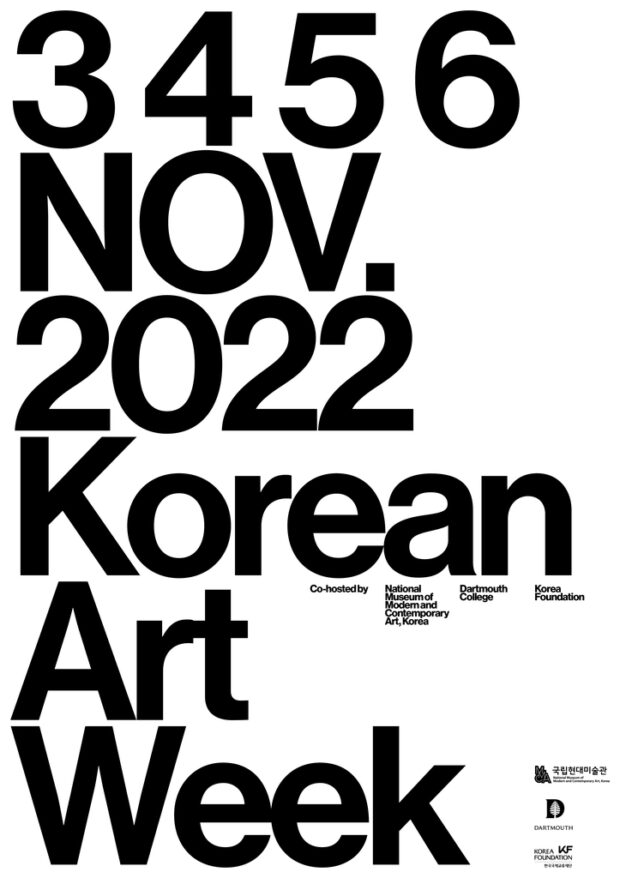


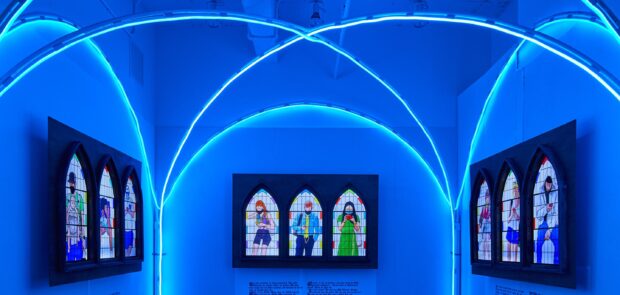

[…] I am capitalizing on my family connections and making three trips to Southern California—over Thanksgiving break, winter break, and in February for the CAA conference—to take in as much of PST as possible. […]
[…] I am capitalizing on my family connections and making three trips to Southern California—over Thanksgiving break, winter break, and in February for the CAA conference—to take in as much of PST as possible. […]